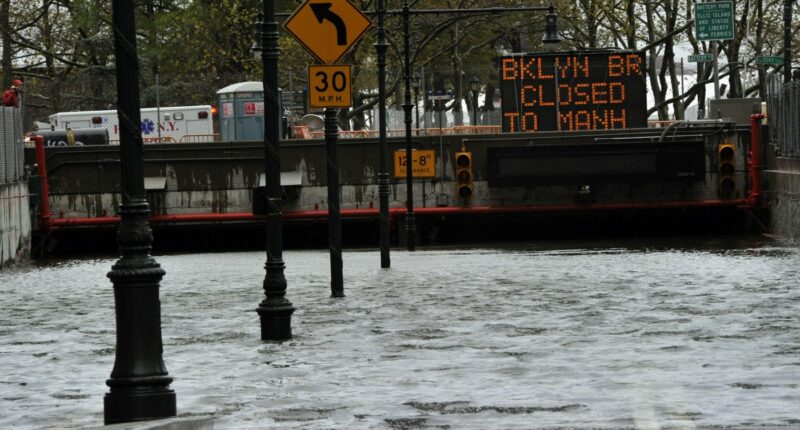Share this @internewscast.com

As we approach October 29, it marks 13 years since Superstorm Sandy unleashed its fury on Lower Manhattan, submerging the area in floodwaters. The storm inflicted over $70 billion in damages on the city, an amount that equates to $95 billion today, starkly highlighting the inadequacy of our infrastructure to withstand the growing threats posed by climate change. Although significant progress has been made in rebuilding and fortifying our coastlines since 2012, the urgent need for continued adaptation remains.
This vulnerability is symptomatic of a larger national crisis. In 2024 alone, the United States endured 27 major climate disasters, taking hundreds of lives and causing billions of dollars in damages. These catastrophic events have become all too familiar. Each summer, even moderate storms are enough to inundate our subway systems and streets. On Manhattan’s West Side, high tides during a full moon can lead to flooding in parts of the neighborhood.
In response, the Battery Park City Authority (BPCA) is spearheading two pivotal resiliency projects under the Lower Manhattan Coastal Resiliency initiative. These initiatives are far from mere theoretical constructs; they are actively under construction, shaped by extensive dialogue and already showing tangible outcomes.
All too frequently, governmental processes become mired in red tape, causing promising ideas to wither in the labyrinth of bureaucracy. Yet in Battery Park City, we are demonstrating that we can bring ambitious concepts to fruition before delays invite disaster.
Wagner Park, one of the area’s cherished green spaces, made a triumphant return this summer. Once again, it is alive with New Yorkers savoring its verdant lawns, meandering paths, and scenic vistas. The park has been elevated above the 100-year flood plain and is now equipped with a concealed floodwall, a state-of-the-art stormwater system, and a 63,000-gallon tank for rainwater reuse.
The advantages of these enhancements reach beyond Battery Park City, offering protection to lower Manhattan against a 100-year storm in the context of anticipated sea level rises. This project adheres to the Waterfront Alliance’s Waterfront Edge Design Guidelines, which encourage projects to exceed standard resilience and environmental benchmarks.
Later this year, the North/West Battery Park City Resiliency Project will break ground, creating a critically-needed coastal flood risk management system. This engineering marvel will create a reliable, passive control barrier that requires no human intervention in the event of a severe storm. It will also preserve the waterfront, maintain open space and introduce universal access, all while minimizing disruption to existing infrastructure.
This is not the first time aspiration and collaboration have come together to deliver public benefit. In the aftermath of the Sept. 11 attacks, plans to rebuild the Port Authority-owned land at the site were floundering, with competing visions, delays and budget issues. Eventually, strong leadership delivered a new World Trade Center and 9/11 memorial in time for the 10th anniversary. It remains one of the city’s shining examples of resilience and architectural ambition.
It is no easy feat to overhaul core public assets in a densely populated area but when a plan is methodically crafted, grounded in science, and shaped by community input, it’s poised to succeed.
For years, the BPCA has laid the groundwork with residents and businesses to gather feedback and make sure final designs reflect local priorities. Coastal communities planning their own large-scale resiliency projects should look to Battery Park City as a model.
While complex in design, the south and north/west sections will provide numerous benefits to Battery Park City and lower Manhattan. Together, they will protect the homes of tens of thousands of New Yorkers, office buildings that drive the city’s economy and essential pieces of infrastructure like the World Trade Center.
The improved shoreline will safeguard against flooding, projected sea level rise and help cool the neighborhood from extreme heat. The removal of Battery Park City from the flood zone will provide relief to homeowners, eliminating the need to purchase flood insurance for federally backed mortgages, and the reconstruction of approximately 1,200 feet of bulkhead will enhance environments that support marine life, a vital part of our ecosystem. Plus, the project is fiscally sound, generating more than $2 in benefit for each dollar invested.
The work happening in Battery Park City joins resiliency work on Manhattan’s East Side to strengthen low-lying perimeter areas from flood risk and sea level rise. It is a monumental undertaking, but the new Wagner Park and the completed phases of the East Side Coastal Resiliency Project show it can be done while transforming our public spaces.
As we reflect on Superstorm Sandy and its wake-up call for the city, lessons were learned and now we must stay focused on following through. As neighborhoods around the city — and cities around the country — look for inspiration amid bureaucratic morass and federal inaction, Battery Park City provides the blueprint for getting it done.
Mann is president and CEO of the Battery Park City Authority. Ward is the interim president and CEO of the Waterfront Alliance.
















